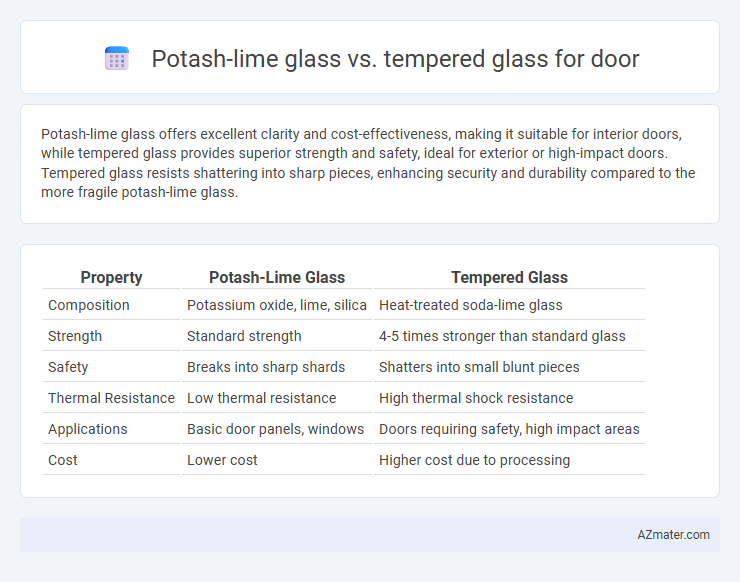Potash-lime glass offers excellent clarity and cost-effectiveness, making it suitable for interior doors, while tempered glass provides superior strength and safety, ideal for exterior or high-impact doors. Tempered glass resists shattering into sharp pieces, enhancing security and durability compared to the more fragile potash-lime glass.
Table of Comparison
| Property | Potash-Lime Glass | Tempered Glass |
|---|---|---|
| Composition | Potassium oxide, lime, silica | Heat-treated soda-lime glass |
| Strength | Standard strength | 4-5 times stronger than standard glass |
| Safety | Breaks into sharp shards | Shatters into small blunt pieces |
| Thermal Resistance | Low thermal resistance | High thermal shock resistance |
| Applications | Basic door panels, windows | Doors requiring safety, high impact areas |
| Cost | Lower cost | Higher cost due to processing |
Introduction to Potash-lime Glass and Tempered Glass
Potash-lime glass, a common type of soda-lime glass containing potassium oxide, offers good clarity and moderate strength, making it suitable for general door applications where basic durability is needed. Tempered glass undergoes a heat treatment process that increases its strength four to five times compared to standard glass, providing enhanced safety and resistance to impact, thermal stress, and bending. Choosing between potash-lime and tempered glass for doors depends on factors like safety requirements, durability, and budget constraints.
Composition and Manufacturing Differences
Potash-lime glass, composed primarily of silica, potash (potassium oxide), and lime (calcium oxide), undergoes a standard annealing process that cools the glass slowly to relieve internal stresses, resulting in ordinary but more brittle glass suited for non-safety applications. Tempered glass is made by reheating annealed potash-lime glass and rapidly cooling it through a quenching process, which induces compressive surface stresses and tensile inner stresses to enhance strength and safety, making it four to five times stronger than regular potash-lime glass. The manufacturing differences lie in the controlled thermal treatment of tempered glass, which improves impact resistance and causes it to shatter into small granular pieces instead of sharp shards, unlike regular potash-lime glass.
Strength and Durability Comparison
Tempered glass features strength up to four times greater than potash-lime glass, making it highly resistant to impacts and thermal stress. Potash-lime glass, while commonly used for its clarity and affordability, is more prone to cracking and shattering under pressure or sudden temperature changes. For door applications requiring enhanced durability and safety, tempered glass offers superior performance by providing increased toughness and safer breakage patterns.
Safety Features and Breakage Patterns
Potash-lime glass, commonly used in standard doors, shatters into large, sharp shards posing significant injury risks during breakage. Tempered glass enhances safety by undergoing a heat treatment process that causes it to break into small, blunt granules, minimizing potential harm. The breakage pattern of tempered glass ensures increased durability and impact resistance, making it a superior choice for door installations demanding stringent safety standards.
Thermal Resistance and Insulation Properties
Potash-lime glass, commonly used in doors, offers moderate thermal resistance with insulation properties that reduce heat transfer, making it suitable for standard thermal performance. Tempered glass enhances safety with increased strength while maintaining comparable thermal insulation to potash-lime glass, but it may have slightly lower thermal resistance due to its manufacturing process. Choosing between potash-lime and tempered glass for doors depends on balancing thermal insulation needs with safety requirements.
Aesthetic Variations and Customization Options
Potash-lime glass for doors offers a classic, clear appearance with high clarity and smooth surface, making it ideal for minimalist and traditional aesthetics, while allowing customization through tinted or patterned options. Tempered glass provides a modern, robust look with enhanced strength and safety features, supporting customization with frosted, etched, or colored finishes that add both visual interest and privacy. Both glass types cater to diverse design preferences, but tempered glass typically delivers broader customization in texture and opacity for contemporary door styles.
Cost Analysis: Potash-lime Glass vs Tempered Glass
Potash-lime glass is generally more cost-effective than tempered glass due to its simpler manufacturing process and lower material costs, making it ideal for budget-conscious door installations. Tempered glass incurs higher expenses because of the additional heat treatment process required to enhance its strength and safety properties. When evaluating cost analysis, potash-lime glass offers savings upfront, whereas tempered glass justifies its premium price with improved durability and safety performance for door applications.
Suitability for Residential and Commercial Doors
Potash-lime glass, known for its clarity and cost-effectiveness, is suitable for residential doors where aesthetic appeal and standard durability are required but impact resistance is less critical. Tempered glass offers superior strength and safety features, making it ideal for commercial doors subject to higher traffic and potential impacts, ensuring compliance with safety codes. For residential use, potash-lime glass provides a budget-friendly option, while tempered glass is preferred in commercial environments for enhanced security and durability.
Maintenance and Longevity Considerations
Potash-lime glass for doors offers moderate durability but requires careful maintenance to prevent scratches and chemical damage, whereas tempered glass provides superior strength and resistance to impact, reducing the risk of breakage and minimizing maintenance needs. Tempered glass undergoes heat treatment that enhances its thermal and mechanical stability, extending its longevity especially in high-traffic or exterior door applications. While potash-lime glass may need periodic replacement or repair due to its vulnerability, tempered glass maintains structural integrity over longer periods, making it a cost-effective and safer choice for long-term door installations.
Conclusion: Choosing the Best Glass for Your Door
Potash-lime glass offers affordability and clarity suited for decorative or interior doors, while tempered glass provides superior strength and safety ideal for exterior or high-traffic doors. Selecting tempered glass ensures enhanced impact resistance and shatterproof qualities, crucial for security and durability. The best choice depends on balancing budget, safety requirements, and door location to optimize performance and aesthetics.

Infographic: Potash-lime glass vs Tempered glass for Door
 azmater.com
azmater.com